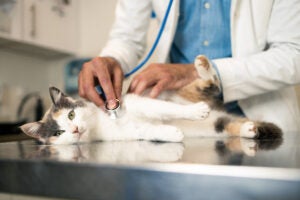What is the cost of routine vet care?



Pets are family, and like any family member, they can be demanding. Yes, your furkids need basics such as food, water and shelter, but you also need to factor in unexpected veterinary expenses and routine vet care costs. To ensure our furry family members are (and stay) happy and healthy, you have to make accommodations for expenses such as vaccinations, parasite control, dental check-ups, wellness exams and even grooming.
Unfortunately, the cost of such routine vet care is on the rise. Many pet owners are feeling the pinch and are left with limited options: cut spending on routine care or look to alternative financing options such as pet insurance and wellness programs. Here, we navigate the cost of routine vet care to help you make an informed decision about how to finance your pet’s needs.
Why routine pet healthcare is important
Unlike emergency vet care, routine pet health care aims to take proactive steps to ensure your pet is and stays healthy. Routine vet care, also known as preventive care, involves preventing and detecting illness or disease in dogs, cats and the occasional exotic pet.
From dental disease to obesity and chronic conditions, there are many health issues you can catch and manage early with a regular vet visit.
- Dental care: Regular dental checks can help prevent and detect common dental issues, such as plaque buildup or gum disease, and more serious conditions like heart disease.
- Grooming: Regular grooming can prevent hot spots and other skin issues for some species and help detect potentially problematic bumps or lumps.
- Parasite prevention: Protects pets from fleas, ticks and internal parasites like worms, all of which can cause major damage if left undetected and untreated.
- Vaccinations: Vaccines protect pets from serious (and often fatal) diseases like rabies and parvovirus.
The costs of routine pet care
Understanding the cost of routine pet care can help you set expectations and prepare for your pet’s needs.
Veterinary exam fees
A routine vet visit may cost anywhere from $50–$250, according to data from CareCredit. However, what you’ll pay can vary based on multiple factors, such as your location and the vet’s services.
Vet fees are more likely to be higher in urban areas due to operational costs and specialized care.
Vaccination fees
Vaccinations protect your pet’s health and prevent the spread of disease to other animals. They’re also required by law in certain jurisdictions. The costs can vary significantly depending on where you live.
Dental care fees
Just like humans, pets need regular dental check-ups. Routine cleanings may not break the bank, but more complex procedures (like extractions) can get pricey. In some cases, dental health problems can lead to severe conditions that might cost even more in the long run.
Factors that affect the costs of care
A few factors can impact how much you’ll pay for your pet’s routine vet care.
- Geographic location: Your location plays a significant role in the cost of vet services. Cities, where the cost of living is higher, often have higher vet prices. You’re likely to pay less in rural areas where the rent, wages and general operational costs are lower for veterinary practices.
- Market dynamics: Vet care prices may be higher in areas where vets are in higher demand. On the other hand, there’s nothing like a sense of competition among vet clinics to keep prices in check.
- Disease risk: Diseases or parasites are more prevalent in some regions than others. Pets living in an area or region with higher infection rates often require more frequent management and treatment, increasing the costs of care.
- Drug costs and availability: Like human medications, veterinary drug costs are often driven by market dynamics. Prescription medications and supplements that are scarce or in high demand often have heftier price tags.
How pet insurance affects routine vet costs
Traditional pet insurance policies typically only cover unexpected illnesses and injuries. However, some of the best pet insurance companies offer comprehensive plans that also include wellness coverage. This coverage can help offset the costs of routine or preventive care, such as vaccinations, dental cleanings, parasite prevention and vet exams.
Not all pet insurance policies cover routine care, and those that do may come with higher premiums. If your pet insurance plan doesn’t cover any routine vet care, consider whether buying wellness coverage in the form of an add-on or rider makes financial sense.
Ways to reduce routine vet costs
Routine care doesn’t have to break the bank. Aside from pet wellness plans, there are a few other ways to manage routine pet care costs:
- Schedule regular wellness checks: Annual exams for healthy pets (semi-annual for seniors) can help with early detection. They also give your vet the opportunity to monitor vaccinations, dental care and parasite control — all of which can help keep Fido or Mittens healthy.
- Personalize your pet’s vaccines: Not all pets need every vaccine. Ask your vet to tailor your pet’s vaccination plan. Your location and your pet’s age, breed and lifestyle are contributing factors in determining whether vaccines are necessary.
- Spay or neuter your pet: Spaying or neutering your pet can prevent various health and behavioral problems. The potential savings can often be worth the added pet insurance premiums or out-of-pocket costs.
- At-home dental care: Brush your pet’s teeth regularly to prevent the buildup of plaque and tartar. This DIY approach is a simple and effective way to reduce the risk of dental disease and save on vet bills.
- Parasite protection: Fleas, ticks and worms can cause serious health problems. Invest in regular parasite prevention treatments to keep your pet protected and help you avoid the price tag that comes with treating parasite-related illnesses.
- Groom your pets at home: Regular grooming at home can contribute to your pet’s overall wellness (and your financial health). It’s a great way to save on professional grooming services and catch potential issues like skin irritations or lumps early on.
- Feed your pet a healthy diet: A balanced, healthy diet can help prevent various diet-related health issues, such as obesity and digestive problems. High-quality pet foods may seem expensive, but they can save you money by preventing costly medical treatments down the road.
- Provide breed- and age-appropriate exercise: Regular exercise tailored to your pet’s breed and age can prevent obesity, which can lead to a host of health problems like joint issues, heart disease and diabetes. Exercise can also manage behavioral problems, reducing the need for (and cost of) professional training and other interventions.
Other ways to save on routine pet care
Even with a solid routine, vet visits can add up. Below are a few more ways to save on routine vet care.
Pay with a cash-back credit card
Using a cash-back credit card to pay vet fees can help you save a small percentage on your bills. While this doesn’t directly reduce the cost of services, you can apply your rewards to future expenses or savings.
When choosing a credit card, look for one that offers high cash-back percentages on general purchases or specifically for medical or pet-related expenses. This way, every time you pay for your pet’s care, you’re effectively getting a discount.
Find out if you qualify for reduced pricing
Some veterinary clinics offer reduced pricing or sliding scale fees for pet owners who meet certain income criteria. If you’re struggling to afford routine care, it’s worth asking your vet if they offer such discounts or if they can refer you to a clinic that does.
Local animal shelters or nonprofit organizations may offer low-cost spay/neuter programs and provide resources or vouchers for discounted veterinary services.
Check out low-cost clinics at veterinary colleges
Veterinary colleges often operate clinics where students care for pets under experienced veterinarians’ supervision. These clinics can offer services at a reduced cost, making them a great option for affordable routine care.
Look for mobile vet clinics and pop-up community clinics
Mobile and pop-up community clinics often offer basic veterinary services at a fraction of the cost you’d find at a traditional clinic. These clinics typically provide essential services such as vaccinations, microchipping and basic check-ups. They are often organized by local animal shelters, nonprofit organizations or even veterinary practices serving underserved communities.
Next steps
The key to affordable and effective pet care is staying proactive. Regular visits, proper grooming and a healthy diet can prevent costly treatments. If you haven’t already, consider exploring pet insurance options that offer wellness add-ons to help manage routine costs.
Is your pet’s vaccination up to date? Are you due for a dental check-up? Whatever step you take next, remember that routine care is an investment in your pet’s long-term health and happiness.
By staying ahead of the curve and making informed choices, you’ll keep your furry friend healthy without breaking the bank.
Frequently asked questions
Why we ask for feedback Your feedback helps us improve our content and services. It takes less than a minute to complete.
Your responses are anonymous and will only be used for improving our website.
You may also like

How insurance raises the total cost of a DUI


How much does pet insurance cost?

